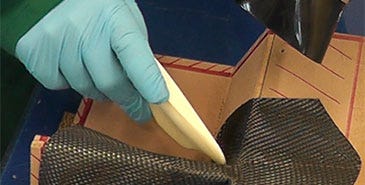A dibber with a difference
Dibbers used to be nothing more than pointy implements used by gardeners since Roman times to dig holes in the ground for planting bulbs or seeds. Now, however, a PhD student from the University of Bristol (UK) has designed and developed a dibber with a difference: a hand-held laminating tool for use in the layup of advanced composite components.
January 7, 2015
Dibbers used to be nothing more than pointy implements used by gardeners since Roman times to dig holes in the ground for planting bulbs or seeds. Now, however, a PhD student from the University of Bristol (UK) has designed and developed a dibber with a difference: a hand-held laminating tool for use in the layup of advanced composite components.
The tool was created by Helene Jones from the Department of Aerospace Engineering who has been exploring the existing design space in the manual layup of composite components as part of her PhD project. Helene is in the second year of her PhD in the Centre for Doctoral Training in Advanced Composites for Innovation and Science.
 Processing aids and tools play an important part in the layup of composite reinforcements to complex geometries. However, despite being frequently used by many industries, no in-depth study of these tools or how they are developed and applied has ever been carried out. The work performed by Ms. Jones has opened up research areas and development paths for investigation.
Processing aids and tools play an important part in the layup of composite reinforcements to complex geometries. However, despite being frequently used by many industries, no in-depth study of these tools or how they are developed and applied has ever been carried out. The work performed by Ms. Jones has opened up research areas and development paths for investigation.
"The use of knowledge such as this into design and manufacture allows us to develop the skill to link design and manufacture seamlessly together. This new understanding has been delivered in a deceptively simple form, but could have major industrial impact for the short and medium terms," said Carwyn Ward, a lecturer in Composites Design, Processing and Manufacture in the Department of Aerospace Engineering,
By working closely with experienced laminators, Helene Jones identified the relationship between the workers and their tools. This led to the development of a series of prototypes, and then a final design and build using a colorless organic thermoplastic polymer, polyether ether ketone (PEEK), to create the dibber.
Using the three key attributes of comfort, geometry matching and force application as a design guide throughout, she has developed a tool that allows for a range of geometries and forming techniques. Early trial results with experienced commercial laminators have suggested that the dibber can be used to great effect, drastically reducing time in a particular layup without negatively impacting on finished quality. The dibber also potentially allows for a more standardized process in design and manufacture, especially if it is incorporated into training. This could lead to a reduction in costs and improve production rates.
"Lamination is a highly skilled manual technique," explains Jones. "It was important to understand why laminators create and use the tools they do. A standardized lamination process will be more successful if it is based on the needs of individual workers, the design, and the process of manufacture. This could lead to a more integrated design for manufacture and in skills training."
Already, some 200 dibbers have been produced and the feedback from the companies using them has been positive. The dibber has also been employed in training demonstrations at the National Composites Centre (NCC). Paul Shakspeare, Head of Training at the NCC said: "The benefits of working with the dibber are that trainees can quickly adopt consistent methods during courses with the specifically designed tool. This early competence is then able to be translated into the workplace using the same tool and techniques."
About the Author(s)
You May Also Like


